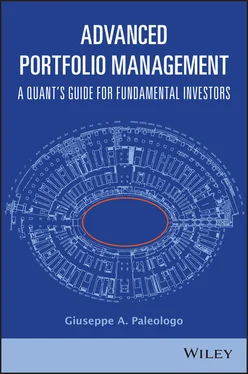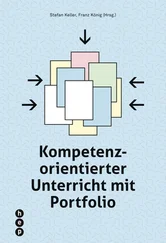Given this example, you can now understand better why SPY has zero percentage idio volatility in Table 3.5. The SPY is a long-only portfolio of 500 stocks. Each stock in the portfolio has a positive beta. As a percentage of the total risk, the idiosyncractic risk is very small, and is usually approximated to zero.
3.5 First Steps in Risk Decomposition
This very simple decomposition already has very powerful implications. Volatility either comes from a systematic source or a stock-specific one. Where does your skill lie? In going long or short the market, or rather in going long or short the company-specific returns? One attractive feature of being long the market is that its risk is accompanied by positive expected returns. The inflation-adjusted annualized historical return of the S&P 500 from 1926 (the inception year of the index) to 2018 is 7%; so it may seem a good idea to have a positive beta to the market. Indeed, a sizable fraction of the global assets under management are actively managed funds that track an index. This means that the portfolio has a positive percentage beta, often equal to 1, and a certain budget of volatility allowed to run in idiosyncratic PnL, sometimes called the tracking error. For example, our previous portfolio in Table 3.5has a tracking dollar vol of $1.9M, or, in percentage of the portfolio's NMV, a 7.8% tracking error. 8 Compared to commercial products, this is a relatively high value. Tracking errors range from 0% (i.e., a “passive” fund tracking the market) to 6 or 7%, which is not hard to achieve when the portfolio consists of hundreds of securities rather than three. One less attractive feature of carrying beta in your portfolio is that it is harder and harder to justify to investors. The principals who entrusted their capital to you also see the alpha-beta decomposition; and they usually have very inexpensive ways to invest in the market, either by buying e-mini SP futures, or by buying a low-expense ratio ETF like SPY, or by investing in a passive fund like Vanguard's Total Stock Market Index Fund. This decomposition, which is useful to you to understand your return, is available to them as well, and the beta component is easy to replicate. Therefore, if you still want to keep a significant beta in your portfolio, you better have a good argument. We will revisit one such argument in Chapter 8, which is devoted to performance. For the time being, it suffices to point out two facts. The first one is that any argument in favor of conflating beta and alpha is weaker than the simple argument in favor of decomposing them. Secondly, that it is easy to remove the market component from a portfolio. This is the subject of the next section.
We revisit the example portfolio in Table 3.5. We had a portfolio with a large amount of market risk, but we also have $6.7M of idiosyncratic risk coming from SYF and WMT. In addition, we have high conviction that these two stocks will have returns in excess of the market in the next quarter, whereas we have very little idea of the direction of the market over the same time horizon. We can express this by saying that we have an edge in our specific stock selections, but not in the market. Even if we did not hold any SPY, we would risk marring our good insight about the underpriced SYF and WMT stock. A large market drawdown can result in negative returns for the portfolio. If we seek absolute returns from our portfolio, this may not be a wise choice. We can remedy this by taking a short position in SPY. We borrow the shares from an existing owner and we sell them at the market price. At some point in the future, we cover the position by purchasing the shares at the market price and returning them to their owner. Shorting has costs and risk. We pay a “borrow rate” to the lender, which can be high if the stocks are hard to find (or locate ). In addition, shorted stocks can be recalled by the original owner if she wants to sell them, forcing us to cover the stock earlier than anticipated. 9 By shorting SPY, we reduce the beta exposure of the portfolio. The dollar beta for SYF is $12M; for WMT it is $2.5M. The total dollar beta is $25.5m. SPY has a beta of 1. If we sell the entire SPY position and further short $15.5M, the total beta of the portfolio is zero. The market component of the portfolio volatility is proportional to its dollar beta, and is therefore zero. And the idiosyncratic risk of the portfolio? It has not changed, because SPY has no idio volatility (to a very good approximation). The summary statistics of the hedged portfolio are in Table 3.7. The procedure is described in Procedure Box 3.2.
Table 3.7 Synchrony, Wal-Mart and SP500 risk parameters, together with holdings for each asset for a market-hedged portfolio.
| Field |
SYF |
WMT |
SPY |
| Beta |
1.2 |
0.5 |
1 |
| Daily Market Vol (%) |
|
|
1.4 |
| Daily Idio Vol (%) |
1.2 |
0.7 |
0.0 |
| Net Market Value ($M) |
10 |
5 |
−15.5 |
Procedure 3.2Compute the market hedge of a portfolio.
1 Compute the dollar betas for the individual positions of the unhedged portfolio;
2 Compute the dollar portfolio beta as the sum of the individual betas;
3 Compute the market hedge NMV, whose value is equal to the opposite of the portfolio beta.
This is perhaps the simplest possible hedging scenario one may imagine, and yet it is applied daily to portfolios with Gross Market Values 10 of hundreds of billions of dollars. These portfolios are usually long-short, but they still do carry beta exposures, which are computed and hedged several times a day using liquid instruments like equity futures. In Chapter 6we will expand the concept in several directions.
3.7 Separation of Concerns
We saw that a simple factor model enables you to do performance attribution, risk decomposition and hedging. These three tasks are tightly connected. If from risk decomposition you can detect that market risk is large, then it is more likely that a substantial fraction of your PnL is attributable to market returns, and this also means that this market risk can be completely hedged, and that the market-originated PnL can be eliminated. Behind it all, this framework enables you to see at work a fundamental design principle: separation of concerns [Dijkstra, 1982]. Disparate activities like building a car, writing the code for a video game or managing a portfolio have one thing in common: they are tasks that require solving many problems at once. If we had to address them all at once, we would likely build a Ford Pinto, 11 release Duke Nukem Forever 12 or be forced to shut down in record time. In order to control complexity, we need to identify smaller, simpler parts of the system; we need to separate them and solve the issues related to them; and finally we have to put them back together with little effort. Modularization, Encapsulation, and Composition. Factor models allow us to separate factor idiosyncratic returns. In the process, they help us separate unwanted risk and performance from intentional risk and performance. When we size our positions, we do so to capture the sources of returns that are specific to a firm. We have a clean way to address the unwanted risk, via hedging. Even better: in the following chapters you will learn about factors and their interpretation, so that the subsystem that constitutes “unwanted risk” can give you context about the investing environment. And this environment can be further decomposed in smaller components, such as country, industry and style risks, which we will cover in the following chapters.
Читать дальше












